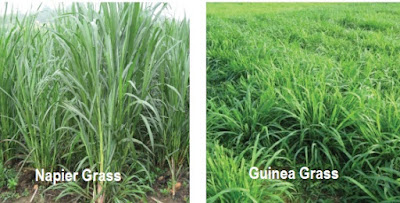Forages are the single most important feed source for ruminants worldwide. Forage is a type of grass or legume used to feed animal in many different forms. It may be fed as pastures or fodder (cut and carry grass) or be conserved as hay, silage or haylage. Several types of forages can be used as pasture or fodder for feeding animals. Guinea grass (Megathrysus maximus) and Napier grass (Pennisetum perpureum) are common fodder grasses that have been used widely. (Wong et al., 1982). In Malaysia, Guinea grass and Napier grass are considered as good palatable fodder for goats along with other grasses (humidicola grass, centrosema, and glyricidia). Guinea grass is native to tropical Africa. It is a major pan tropical grass used throughout the tropics for pasture, cut-andcarry, silage and hay. It is a fast growing and leafy grass, which is palatable to livestock with a good nutritional value. However, it is generally recommended to supplement it with sources of protein in order to meet nutritional requirements or improve animal performance. Guinea grass is an ideal forage plant as it grows well on wide variety of soils and even under light shade of trees and bushes and can survive long dry spells and quick-moving fires which does not harm the underground roots. Guinea grass can produce yields an average of 30 t DM/ha/ year (Cook et al., 2005). The yields depend on the cultivar and fertilizer application. For instance, unfertilized Guinea grass yields around 7 t DM/ha while N-fertilized pastures can yield up to 42 t/ha.
For longterm maintenance of stand, it should not be cut or grazed below about 30 cm, and should be cut or grazed at about 4-weekly intervals to obtain best balance between quality and quantity. Napier grass originated from subSaharan tropical Africa (Clayton et al., 2013). It has been introduced as forage into most tropical and subtropical regions worldwide. It is a very versatile species that can be grown under a wide range of conditions and systems: dry or wet conditions, smallholder or larger scale agriculture. It is a valuable forage and very popular throughout the tropics, notably in cut-and-carry systems (Mannetje, 1992; FAO, 2015). Napier grass is a full sunlight species that can still produce under partial shade but does not withstand complete shade under a dense tree canopy (Francis, 2004). Napier grass is fast growing and has a high annual productivity that depends on the climatic conditions, especially temperature and rainfall (Aroeira et al., 1999). Napier grass requires high levels of fertilizer and a regular water supply (Mannetje, 1992). Yields range from 20 to 80 t DM/ha/year under high fertilizer inputs (Francis, 2004; Skerman et al., 1990). With no, or inadequate, fertilizer, yields are in the range of 2-10 t DM/ha/year (Bogdan, 1977). Generally, the recommended age to harvest Napier grass is at 6 to 8 weeks of growth, to optimize the dry matter yield and nutritive value (Lounglawan et al., 2004). The aim of this study was evaluated a potential grasses for goat to get an optimum growth performance and optimum feeding cost.
Feedings goats with Guinea grass and Napier grass showed no significant difference of the growth performance of goats. Feeding Napier grass produced optimum weight with low DMI and FCR than those fed with Guinea grass. Low FCR is needed in livestock production because it means that more output is produced with less feed. It is recommended to choose Napier grass as a potential grass to obtain an optimum growth performance and optimum feeding cost for their daily operational ranch. In addition, Napier grass provided a high annual productivity compared to guinea grass and it will be a better choice for farmers. Due to high feed costs, farmers in tropical regions are encouraged to use the naturally available fodders for livestock farming.
Thanks...
By,
M Anim,
Senior Agronomist,
Precint 11, Putrajaya,
Malaysia.
(September 2020).





Thank you for this great information information
ReplyDelete